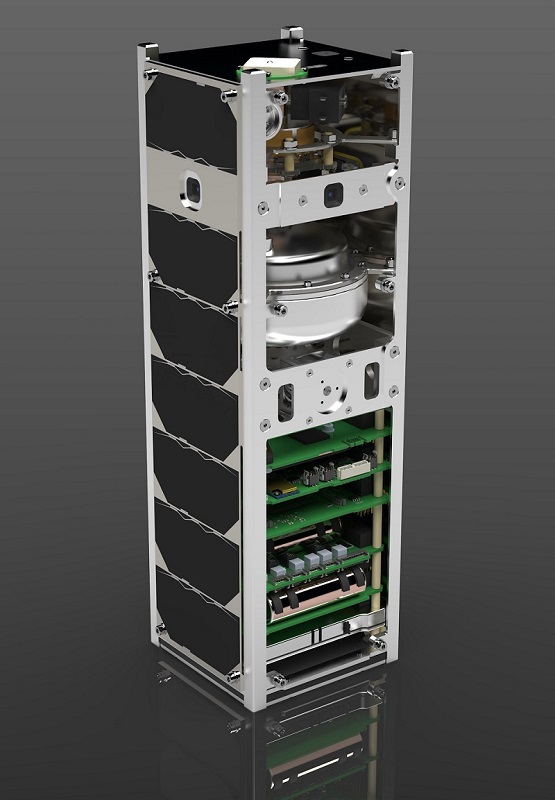PW-Sat3 – the third student satellite from WUT is under construction
They started working on the project in October 2018. As they admit, they were inspired by the successes of their older fellow students - the creators of PW-Sat - the first Polish satellite in space and PW-Sat2, which successfully tested the deorbital sail - a possible solution to the problem of space debris. What are the goals of students working on PW-Sat3?
- The main goals of the mission are to test the "cold gas" propulsion system we designed to control the orbit and the experiment of the partner company KP Labs - says Krzysztof Zając, PW-Sat3 engineer. - The principle of operation of "cold gas" drives is based on the release of the gas accumulated in the tank under high pressure through the nozzle. In this way, a thrust is generated, which makes it possible to change the speed of our satellite, and thus the parameters of its orbit. Compared to standard engines of this type, our power unit differs in the presence of an additional heating chamber in which the gas is heated before it hits the nozzle. This makes it possible to increase the efficiency of the engine.
The Mission Plan
- Our experiment is, in a sense, a continuation of the work of our predecessors - such a propulsion system can be used to deorbit the satellite - Krzysztof Zając continues. - In recent days, there has been a close flight of satellites from the competing constellations Starlink and OneWeb. In such situations, motorised units can properly plan maneuvers and minimize the risk of a collision. In the space industry, we currently have a great demand for this type of device.
In addition to the drive, the satellite will also carry the Antelope on-board computer with Oryx software designed by KP Labs. During the mission, there will be a demonstration of the device - an experiment using machine learning algorithms will be conducted during the first weeks of the mission. The company's employees also provide substantive support to students during the preparation of software and tests.
– As part of complementary experiments, we plan to take pictures of our planet and test - as far as we know - an unconventional horizon sensor system - says Jakub Olesz, PW-Sata3 engineer. - Such devices make it possible to determine the orientation of the satellite also during eclipses, unlike popular solar sensors.
It is also worth noting that facing the challenges posed by outer space is an extremely valuable experience for all those who want to start working in the space sector.
The PW-Sat3 will measure about 10x10x34 cm and weigh about 4 kg. This size corresponds to the CubeSat 3U standard, where one "U" unit is approximately 10x10x10cm. PW-Sat and PW-Sat2 are CubeSats in the sizes of 1U and 2U, respectively, although the PW-Sat2 significantly increased its dimensions after unfolding the deorbitation sail.
Team Work
PW-Sat3 is the work of a team from the Students' Space Association, which operates at the Faculty of Power and Aeronautical Engineering. It is currently made up of 27 people from 4 faculties of the Warsaw University of Technology. Students from other Polish universities are also involved in the project.
- We started work on PW-Sat3 in October 2018, i.e. before the launch of the previous satellite - recalls Marcin Pulik, PW-Sat3 project coordinator. - Those interested ones participated in meetings with PW-Sat2 engineers, who tried to provide us with as much information as possible about potential problems that could stand in our way.
It was then that the mission objectives were defined and teams for configuration, mission analysis, thermals, control system, electronics, and drive design emerged.
Further Plans
- We are currently finalizing the last details of the initial design of the satellite and organizing a test campaign for the first functional version of the engine - we have recently received the necessary elements from the workshop - explains Marcin Pulik. - Electronics prepare the drive controller software in cooperation with the project partner - KP Labs. Our plans for the coming months also include the construction of a structural and thermal model of the entire satellite and the launch of a stratospheric balloon to test infrared sensors for horizon detection.
You can still join the PW-Sat3 team.
- We invite you to contact us via kontakt@pw-sa all who believe that they can contribute something valuable to the project: sponsors, electronics / automation engineers and people interested in the promotional department - says Marcin Pulik.
The launch of PW-Sat3 is planned for 2023.









